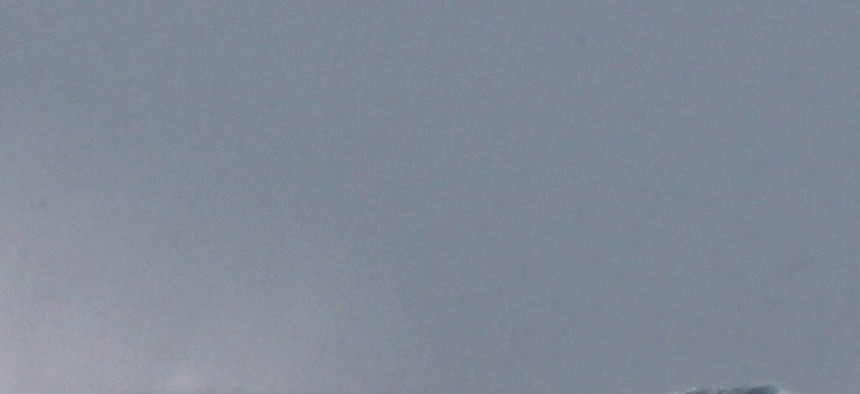
A boat is thrashed by waves near Jeju Island, which is near Sokora Island Kim Ho-cheon/AP Photo/Yonhap
Is This Submerged Rock East Asia's Next Flashpoint?
Caught between China, Japan and South Korea, this underwater island could become become another spot where tempers flare. By Lily Kuo
This story has been updated.
There is a submerged rock in the Yellow Sea that seafaring Korean families once believed to be the home of the spirits of dead fishermen. The rock’s name in English is Socotra Rock; in Korea, it’s referred to as Ieodo, and in China the Suyan Rock. Whatever the language, it’s at the center of a new global hot zone that is threatening to destabilize relations in East Asia.
In response to China’s creation of a controversial air defense identification zone two weeks ago, the South Korean government has expanded its air defense identification zone as well. As of Dec. 15, Korea’s ADIZ will be about 66,480 sq. km larger—about two thirds the size of the country—and encompass Socotra, which China also included in its air defense zone. South Korean officials had asked China to remove Socotra from its ADIZ, but Chinese officials refused. Further complicating matters, the rock also falls under Japan’s air defense identification zone, though the country doesn’t make any claims to it.

The Green line outline’s Japan’s ADIZ set up by Japan. The blue dotted line is South Korea’s current ADIZ and the red line shows how far it will be extended. The gray dotted line is China’s ADIZ. AP/Lee Jin-man
Both China and Korea say the rock, submerged about five meters (15 feet) below the sea’s surface, is part of their “exclusive economic zones” (EEZ). UN maritime law says that a country’s EEZ extends up to 370 km from its territory, but also that submerged rocks can’t be claimed by any country as territory. (Nations can, however, control and use the sea and natural resources around the rock.)

The conflict over this little-known rock has mostly been overshadowed by higher profile territorial disputes like the Senkaku/Diayu Islands in the East China Sea, and the Spratly Island chains in the South China Sea. But in some ways, Socotra is just as pivotal. South Korea has built a maritime research station and helipad atop the submerged rock, which sits in the middle of most of Korea’s incoming and outgoing sea traffic. Some scientists think the reef is home to natural gas and mineral deposits. Korea is also building a new naval base on the nearby Jeju Island, a move that some security observers say is a response to China’s rising military power.
For now, though, the risk of conflict still appears low. China has responded by saying only that Beijing “ expresses regret over South Korea’s expansion of its air defense identification zone” and that officials hard registered their concern with Seoul. The two countries are in a phase of relatively good diplomatic relations, characterized by increasing trade . But if people start glimpsing the top of the rock, it might be time to start worrying—according to Korean legend it’s an omen of imminent seaborne danger.




